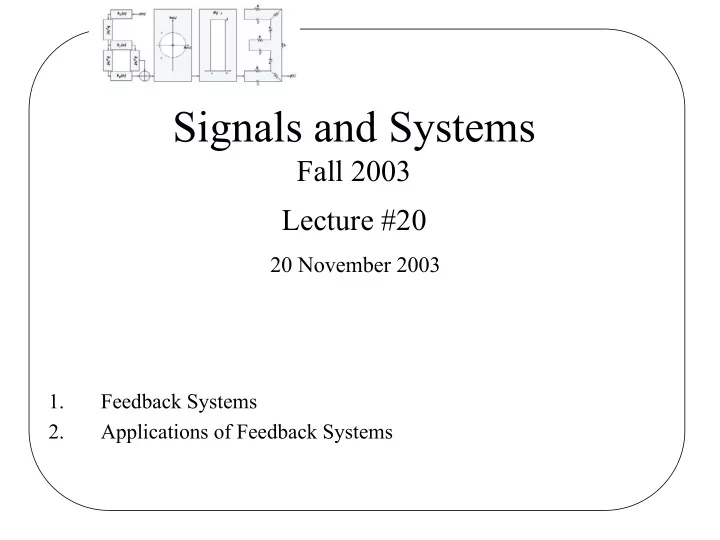

Signals and Systems Fall 2003 Lecture #20 20 November 2003 1. Feedback Systems 2. Applications of Feedback Systems
A Typical Feedback System Why use Feedback? • Reducing Effects of Nonidealities • Reducing Sensitivity to Uncertainties and Variability • Stabilizing Unstable Systems • Reducing Effects of Disturbances • Tracking • Shaping System Response Characteristics (bandwidth/speed)
One Motivating Example Open-Loop System Closed-Loop Feedback System
Analysis of (Causal!) LTI Feedback Systems: Black’s Formula CT System Black’s formula (1920’s) Closed - loop system function = forward gain 1 - loop gain Forward gain — total gain along the forward path from the input to the output Loop gain — total gain around the closed loop
Applications of Black’s Formula Example: 1) 2)
The Use of Feedback to Compensate for Nonidealities Assume KP ( j ω ) is very large over the frequency range of interest. In fact, assume — Independent of P(s)!!
Example of Reduced Sensitivity 1)The use of operational amplifiers 2)Decreasing amplifier gain sensitivity Example: ω = ω = (a) Suppose KP ( j ) 1000 , G ( j ) 0 . 099 1 1 1000 ω = = Q ( j ) 10 1 + 1 ( 1000 )( 0 . 099 ) (b) Suppose ω = ω = KP ( j ) 500 , G ( j ) 0 . 099 2 2 (50% gain change) 500 ω = ≅ Q ( j ) 9 . 9 (1% gain change) 2 + 1 ( 500 )( 0 . 099 )
Fine, but why doesn’t G ( j ω ) fluctuate ? Note: For amplification, G ( j ω ) must attenuate , and it is much easier to build attenuators ( e.g. resistors) with desired characteristics There is a price: Needs a large loop gain to produce a steady (and linear ) gain for the whole system. ⇒ Consequence of the negative ( degenerative ) feedback.
Example: Operational Amplifiers If the amplitude of the loop gain | KG ( s )| >> 1 — usually the case, unless the battery is totally dead. Then Steady State The closed-loop gain only depends on the passive components ( R 1 & R 2 ), independent of the gain of the open-loop amplifier K .
The Same Idea Works for the Compensation for Nonlinearities Example and Demo: Amplifier with a Deadzone The second system in the forward path has a nonlinear input-output relation (a deadzone for small input), which will cause distortion if it is used as an amplifier. However, as long as the amplitude of the “loop gain” is large enough, the input-output response ≅ 1/ K 2
Improving the Dynamics of Systems Example: Operational Amplifier 741 The open-loop gain has a very large value at dc but very limited bandwidth Not very useful on its own
Stabilization of Unstable Systems • P ( s ) — unstable • Design C ( s ), G ( s ) so that the closed-loop system is stable ⇒ poles of Q ( s ) = roots of 1+ C ( s ) P ( s ) G ( s ) in LHP
Example #1: First-order unstable systems
Example #2: Second-order unstable systems — Unstable for all values of K Physically, need damping — a term proportional to s ⇔ d / dt —
Example #2 (continued): Attempt #2: Try Proportional-Plus-Derivative (PD) Feedback — Stable as long as K 2 > 0 (sufficient damping) and K 1 > 4 (sufficient gain).
Example #2 (one more time): Why didn’t we stabilize by canceling the unstable poles? There are at least two reasons why this is a really bad idea: a) In real physical systems, we can never know the precise values of the poles, it could be 2± ∆ . b) Disturbance between the two systems will cause instability.
Demo: Magnetic Levitation i o = current needed to balance the weight W at the rest height y o Force balance Linearize about equilibrium with specific values for parameters — Second-order unstable system
Magnetic Levitation (Continued): — Stable!
Recommend
More recommend